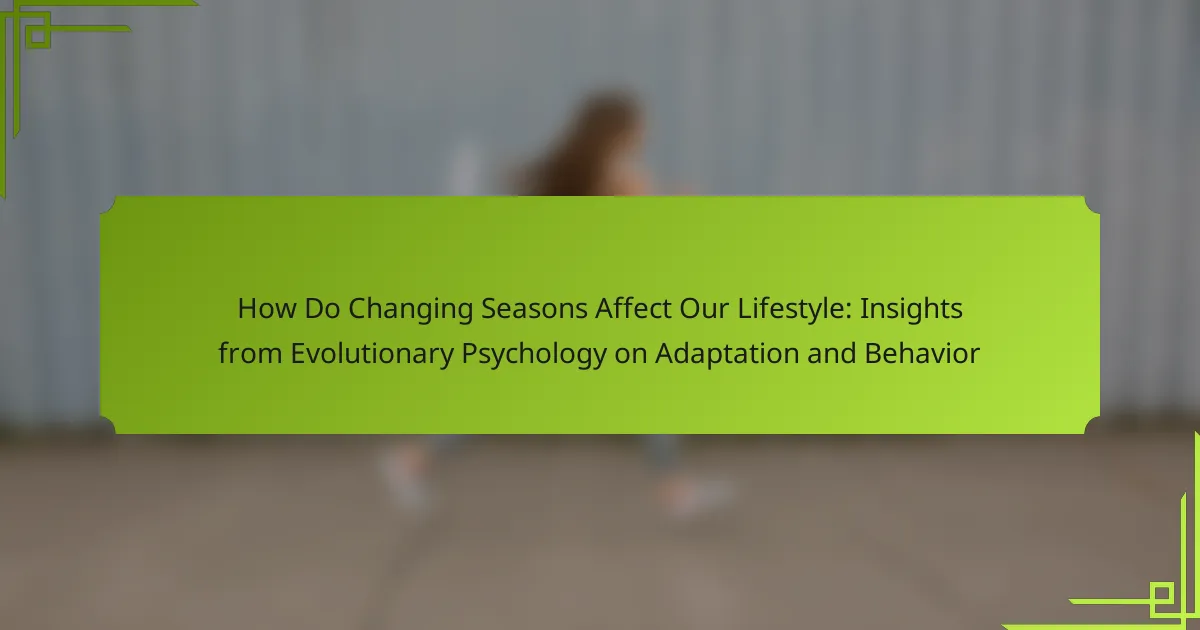Changing seasons significantly influence our lifestyle choices, affecting mood, activity levels, and social interactions. Evolutionary psychology reveals how humans adapt behaviours for survival, with seasonal variations impacting diet, exercise routines, and social gatherings. Understanding these patterns allows individuals to align their activities with seasonal shifts, ultimately enhancing well-being.

How do changing seasons impact our lifestyle choices?
Changing seasons significantly influence our lifestyle choices, shaping behaviours and preferences. Seasonal changes affect mood, activity levels, and social interactions. For example, winter may encourage indoor activities, while summer promotes outdoor engagement. Adaptation is rooted in evolutionary psychology, where humans historically adjusted behaviours for survival. Seasonal variations can lead to changes in diet, exercise routines, and even social gatherings. Understanding these patterns helps individuals align their activities with seasonal shifts, enhancing overall well-being.
What are the evolutionary roots of seasonal behaviour?
Seasonal behaviour has deep evolutionary roots, shaped by survival needs and environmental changes. Our ancestors adapted their lifestyles to seasonal variations, influencing food availability and shelter requirements. These adaptations fostered behaviours like migration, hibernation, and resource gathering, optimising survival. Understanding these roots reveals how modern humans still respond to seasonal cues, affecting mood, activity levels, and social interactions.
How do seasonal changes influence mental health?
Seasonal changes significantly influence mental health by affecting mood, energy levels, and overall well-being. Research indicates that shorter days and reduced sunlight during winter months can lead to seasonal affective disorder (SAD), characterised by symptoms such as depression and lethargy. Conversely, spring and summer often correlate with increased energy and improved mood due to longer daylight hours and more outdoor activities.
Evolutionary psychology suggests that these adaptations are rooted in our ancestors’ need to respond to environmental changes for survival. For example, the availability of food and social interactions fluctuated with seasons, impacting mental states and behaviours. Understanding these patterns can help individuals develop coping strategies, such as light therapy in winter or engaging in outdoor activities during warmer months, to enhance mental health throughout the year.
What seasonal affective disorder (SAD) reveals about human adaptation?
Seasonal affective disorder (SAD) highlights the human ability to adapt to environmental changes. This condition reflects how reduced sunlight during winter months impacts mood and behaviour. Evolutionary psychology suggests that these adaptations may have roots in survival mechanisms. For instance, lower light exposure triggers changes in serotonin levels, influencing energy and emotional states. Understanding SAD reveals the intricate relationship between seasonal changes and human psychology, emphasising the importance of light for mental well-being.
What universal lifestyle adaptations occur during seasonal transitions?
Seasonal transitions prompt various lifestyle adaptations, including changes in diet, activity levels, and social interactions. As winter approaches, people often consume more calorie-dense foods, while summer encourages lighter meals. Activity levels fluctuate with temperature; outdoor exercise increases in warmer months, while indoor activities prevail in colder seasons. Social interactions also shift, with gatherings more common during pleasant weather. These adaptations reflect evolutionary psychology, showcasing how human behaviour evolves in response to environmental changes.
How do dietary habits shift with the seasons?
Dietary habits shift with the seasons as people adapt to environmental changes. In winter, individuals often consume more hearty, calorie-dense foods to maintain energy levels and warmth. Conversely, summer brings lighter meals, emphasising fresh fruits and vegetables. These seasonal shifts reflect evolutionary adaptations to climate and resource availability. Research indicates that these changes can impact nutrition and health outcomes, influencing overall well-being.
What are common physical activity changes throughout the year?
Seasonal changes significantly impact physical activity levels and types. In winter, people often engage in indoor exercises due to colder weather, while summer encourages outdoor activities like hiking and swimming.
Spring typically sees an increase in outdoor sports as temperatures rise, promoting social activities. Autumn often shifts focus to preparation for winter sports, with activities like running or cycling becoming popular.
These seasonal adaptations reflect evolutionary psychology, highlighting our innate responses to environmental changes. Understanding these patterns can help individuals optimise their fitness routines throughout the year.
What unique behavioural patterns emerge in response to seasonal changes?
Seasonal changes trigger distinct behavioural patterns in humans, influencing activities, mood, and social interactions. For example, during spring and summer, increased daylight often enhances outdoor activities and social gatherings. Conversely, colder months may lead to more indoor behaviours and introspection. Research indicates that these shifts are rooted in evolutionary adaptations, where survival instincts dictate changes in behaviour based on environmental conditions. Seasonal affective disorder exemplifies how mood can fluctuate with the seasons, highlighting the psychological impact of light and temperature variations.
How do social interactions vary by season?
Social interactions vary by season due to environmental changes and human adaptability. In spring and summer, increased sunlight and warmth promote outdoor activities and social gatherings. Conversely, autumn and winter often lead to more indoor interactions, influenced by colder weather and shorter days. Seasonal affective disorder can also affect social behaviour, leading to decreased interaction in winter months. Understanding these patterns highlights the impact of seasonal changes on our lifestyle and social connections.
What role does seasonal fashion play in social signalling?
Seasonal fashion serves as a vital form of social signalling, reflecting personal identity and group affiliation. It allows individuals to communicate status, cultural belonging, and adherence to trends. For example, specific styles may indicate social class or regional identity, while seasonal changes prompt shifts in wardrobe that align with societal expectations. This behaviour is rooted in evolutionary psychology, where adapting to environmental changes enhances social cohesion and acceptance. Seasonal fashion choices thus become a unique attribute of social interaction, influencing perceptions and relationships within communities.
What rare seasonal adaptations have been observed in human behaviour?
Humans exhibit rare seasonal adaptations such as altered sleep patterns, changes in mood, and variations in social behaviour. Seasonal affective disorder (SAD) exemplifies how winter’s reduced sunlight can lead to depressive symptoms. Additionally, during summer, increased outdoor activity fosters stronger social connections. These adaptations reflect evolutionary responses to environmental changes.
How do extreme weather events shape lifestyle changes?
Extreme weather events significantly influence lifestyle changes by prompting adaptations in behaviour and social structures. For example, increased frequency of heatwaves leads to altered daily routines, such as shifting work hours to cooler parts of the day. Additionally, extreme weather can drive migration patterns, as communities relocate to more stable climates. These adaptations reflect evolutionary psychology principles, where survival drives behavioural shifts. Moreover, individuals may develop new coping strategies, such as enhanced community support systems, to manage the stress associated with extreme weather. Understanding these dynamics is crucial for anticipating future lifestyle changes in response to climate variability.
What unusual cultural practices arise in response to seasonal changes?
Cultural practices often shift with seasonal changes, reflecting adaptations to environmental conditions. For example, winter solstice celebrations emphasise light and warmth, countering darkness. In spring, rituals may focus on fertility and renewal, aligning with agricultural cycles. These practices foster community bonds and address psychological needs. Seasonal festivals, like harvest celebrations, enhance social cohesion and gratitude. Unique attributes of these practices include local traditions and variations, which enrich cultural diversity.
How can understanding seasonal effects improve our well-being?
Understanding seasonal effects can significantly enhance our well-being by promoting adaptive behaviours. Seasonal changes influence mood, energy levels, and social interactions. For example, research shows that exposure to natural light during longer days can boost serotonin levels, improving mental health. Additionally, seasonal activities encourage physical exercise, which is linked to better overall health. By recognising these patterns, individuals can adjust their routines to align with seasonal rhythms, leading to improved emotional and physical well-being.
What best practices can enhance adaptation to seasonal changes?
To enhance adaptation to seasonal changes, prioritise establishing routines that align with seasonal rhythms. Engage in outdoor activities to benefit from natural light exposure. Adjust diet to include seasonal produce for optimal nutrition. Cultivate mindfulness practices to manage stress associated with transitions. Embrace flexibility to adapt plans as weather conditions change.
What common mistakes do people make regarding seasonal lifestyle adjustments?
People often overlook the need for gradual adjustments to their routines during seasonal changes. Common mistakes include failing to adapt physical activity levels, neglecting dietary shifts, and ignoring mental health impacts. For instance, many individuals maintain summer exercise routines in winter, leading to burnout or injury. Additionally, seasonal affective disorder can arise from inadequate light exposure, yet people may not recognise its symptoms. Lastly, disregarding the importance of seasonal clothing can result in discomfort and health issues.
What expert insights can guide better seasonal adaptation strategies?
Understanding expert insights can enhance seasonal adaptation strategies by aligning behaviours with evolutionary psychology. Seasonal changes influence mood, energy levels, and social interactions. Experts suggest cultivating awareness of these shifts to optimise routines. For example, adjusting sleep patterns and diet can mitigate seasonal affective disorder. Additionally, engaging in outdoor activities during daylight can boost mental health. Emphasising social connections during colder months fosters resilience. Implementing these insights can lead to improved well-being and adaptability throughout the year.
